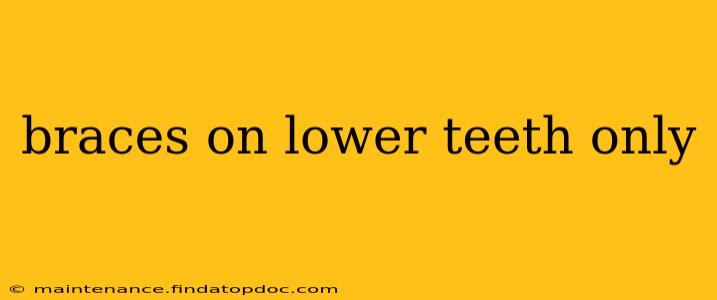Many people wonder about the possibility of getting braces only on their lower teeth. This isn't as uncommon as you might think, and it's a perfectly viable orthodontic treatment option in certain situations. This comprehensive guide will explore the reasons why someone might need lower braces only, the process involved, and what you can expect.
Why Would I Only Need Braces on My Lower Teeth?
This is often the first question people ask. Several reasons could necessitate treatment focusing solely on the lower arch:
-
Overbite Correction: A significant overbite (where the upper teeth overlap the lower teeth excessively) can sometimes be addressed by addressing the lower jaw's position. By moving the lower teeth forward, the overall bite relationship can be improved.
-
Crossbite Correction: A crossbite occurs when the upper teeth are inside the lower teeth, causing an improper bite. In some cases, this can be corrected by adjusting the lower arch's alignment.
-
Spacing Issues: Crowding or gaps in only the lower teeth may require treatment to improve aesthetics and function.
-
Lower Jaw Misalignment: Problems with the alignment of the lower jaw itself, independent of the upper jaw, may be corrected with braces solely on the lower teeth.
-
Post-Treatment Refinement: In some cases, after comprehensive orthodontic treatment, minor adjustments might be needed on only the lower arch.
What's the Process of Getting Lower Braces Only?
The process is very similar to getting braces on both arches, albeit on a smaller scale. Your orthodontist will:
-
Conduct a Thorough Examination: This will involve taking X-rays, photographs, and impressions of your teeth to assess the alignment and create a treatment plan.
-
Create a Customized Treatment Plan: Based on the diagnosis, your orthodontist will devise a specific plan to address the identified issues.
-
Bond the Brackets: Small brackets will be bonded to the surface of each tooth on the lower arch.
-
Attach the Archwire: A thin wire is threaded through the brackets to apply gentle pressure and gradually move the teeth into the desired position.
-
Regular Adjustments: You will need to return for regular adjustments, typically every 4-6 weeks, where the orthodontist will tighten the wire to continue the tooth movement.
How Long Does Treatment Typically Take?
The duration of treatment varies depending on the severity of the misalignment and individual response to treatment. It’s generally shorter than full-arch treatment, but could still range from six months to two years.
How Much Does It Cost?
The cost of lower braces only is typically less than full-arch treatment, but this varies significantly depending on your location, orthodontist, and the complexity of your case. It's crucial to consult with an orthodontist for an accurate cost estimate tailored to your specific needs.
What Are the Potential Side Effects?
While generally safe and effective, lower braces can cause some minor side effects, including:
-
Discomfort and Soreness: This is most common during the initial placement and after adjustments.
-
Irritation of Soft Tissues: The brackets and wires can sometimes irritate the gums and cheeks.
-
Difficulty Eating Certain Foods: You may need to adjust your diet to avoid hard or sticky foods that could damage the braces.
-
Speech Difficulties: You may experience a slight lisp initially, but this typically subsides as you adjust to the braces.
These side effects are generally temporary and manageable. Your orthodontist can offer advice and solutions to alleviate any discomfort.
Can I Get Invisalign for My Lower Teeth Only?
While less common than traditional braces for only the lower arch, it’s possible to use Invisalign aligners on only the lower teeth. This approach is suitable for certain cases where the misalignment is limited to the lower arch and Invisalign is deemed appropriate by the orthodontist.
Are There Alternatives to Braces for Lower Teeth Only?
In some cases, alternatives to braces might be considered, such as clear aligners or removable appliances. However, the suitability of these alternatives depends on the specific orthodontic problem. Your orthodontist will determine the most appropriate treatment option for your individual needs.
What Happens After Treatment?
After the treatment period is complete, your orthodontist will remove the braces and may recommend a retainer to maintain the improved alignment of your teeth. Regular follow-up appointments are crucial to ensure the long-term stability of your teeth's position.
This article aims to provide general information and should not be considered a substitute for professional advice. Always consult with a qualified orthodontist to discuss your individual needs and treatment options.
